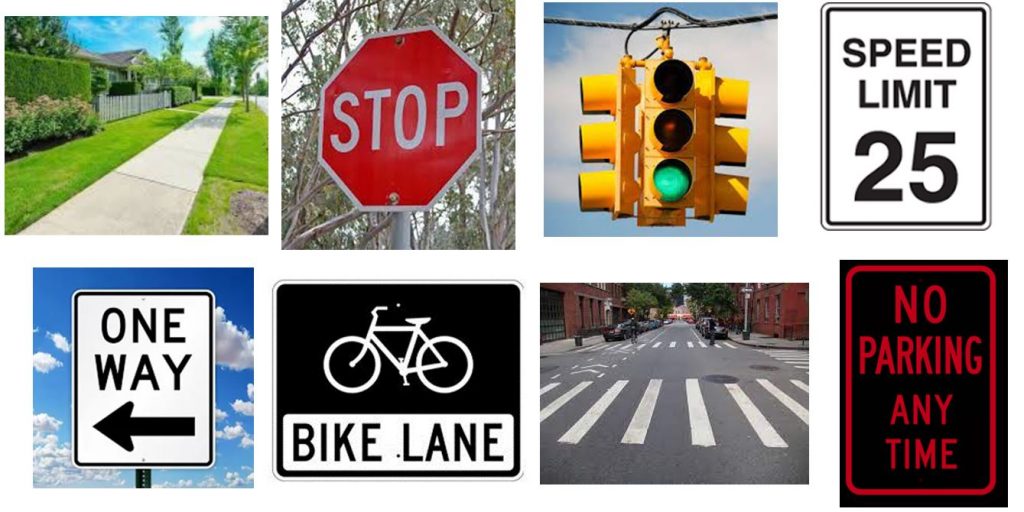PART 1: ORGANIZED AND ORGANIZING
When your room or closet or school locker is messy or disorganized, your parents or teacher might notice and talk about it… and maybe you do too. But when things are organized, we usually don’t notice it or think about how and why its “ORGANIZING SYSTEM” works. In this book you will learn how to analyze any organizing system, and those new skills will also enable you to design the organizing system for any collection of things you need to interact with. Those analysis and design skills will also enable you to organize your time and events in an effective schedule.
Here’s an example of a essential organizing system that you rarely notice or think about – the “Neighborhood Organizing System.”

BOTTOM ROW: One Way Sign, Bike Lane, Crosswalk, No Parking Sign
As you learn more about organizing, you’ll see that there are usually many ways to organize the same things. There can also be many ways to analyze an organizing system. For example, we can analyze the different parts of the neighborhood organizing system according to whether they are organizing motor vehicles or pedestrians. Here is a little quiz to start your practice at becoming a master organizer.
Here are more examples of things that can be organized in very different ways:
- You could arrange your clothes closet by type (separating jeans, shirts, and sweaters), by purpose (school, sports, parties), by season, or by color.
- Fast food, cafeteria buffets, and sit-down restaurants organize their menus and eating areas differently
- Animals are organized differently in zoos, wild animal parks, and natural history museums
- The students in a school district can be organized by school, by grade, or by homeroom teacher. For some purposes the students in a particular classroom are organized are lined up according to the alphabetical order of their last names
Sometimes the features or properties that organize the collection are easy to see. You sort your clothes according to the part of your body they go on. You sorted your Lego bricks by their colors, sizes, and shapes when you first started playing with them. But at other times the organizing principles use features that you can’t directly see. Books are usually sorted by their subject matter, and you can’t tell someone’s name by looking at them.
This book has many activities and questions that will help you understand what it means to be organized and how to organize anything. We will study many different organizing systems — libraries, supermarkets, zoos, sports teams, schools, calendars, schedules, and many others. This isn’t because you are going to organize a library, supermarket, or zoo anytime soon, but learning a little about how they are organized will make going to them more efficient and more interesting for you. And comparing and contrasting different organizing systems is the best way to learn the concepts and design methods that make up the discipline of organizing.
Organizing takes time to do well, but it usually saves a lot more time in the long run because you can interact with organized things more easily and efficiently than if they are not organized. This book will also teach you to organize your time better, giving you more time to have fun, hang out, or just enjoy the passing of time.
Mastering the discipline of organizing will help you to be successful in school, your job, as a member of your family, and in everything else you do during your lifetime. This book will get you started on the path to that important goal.

